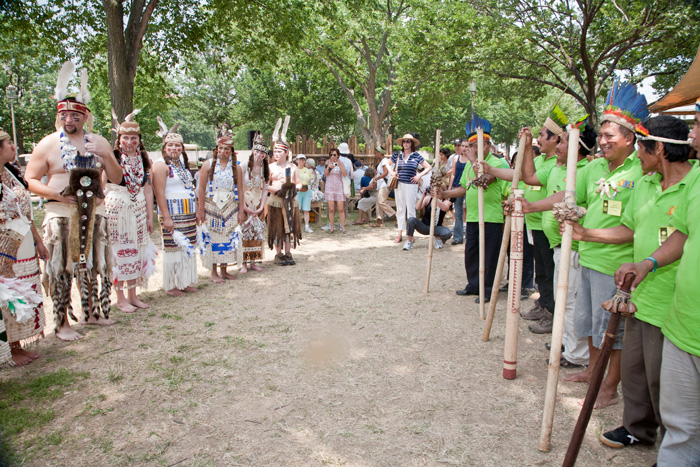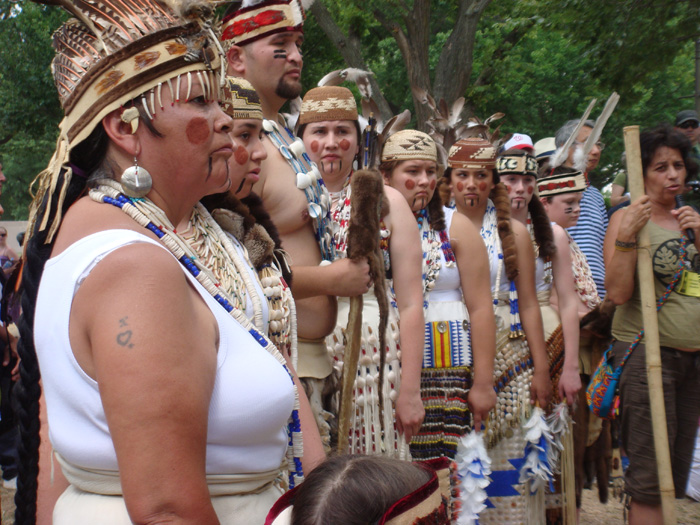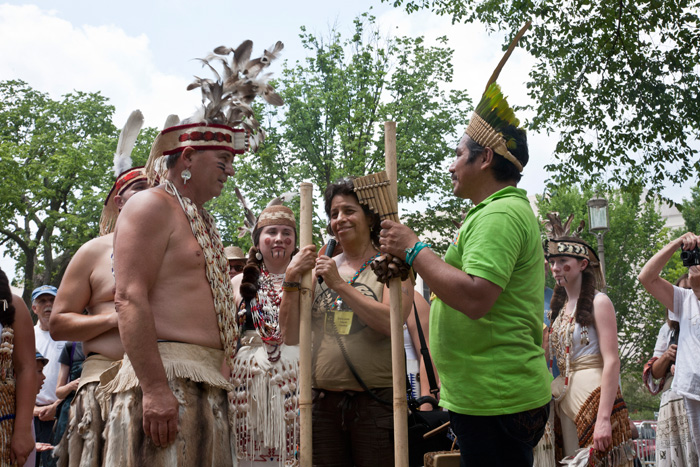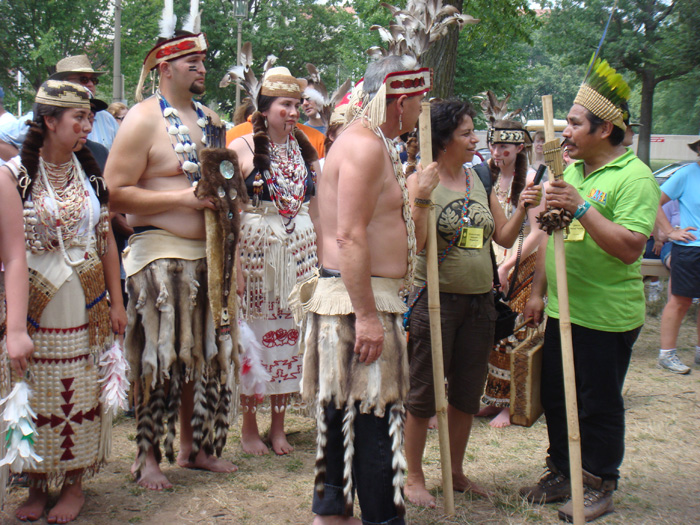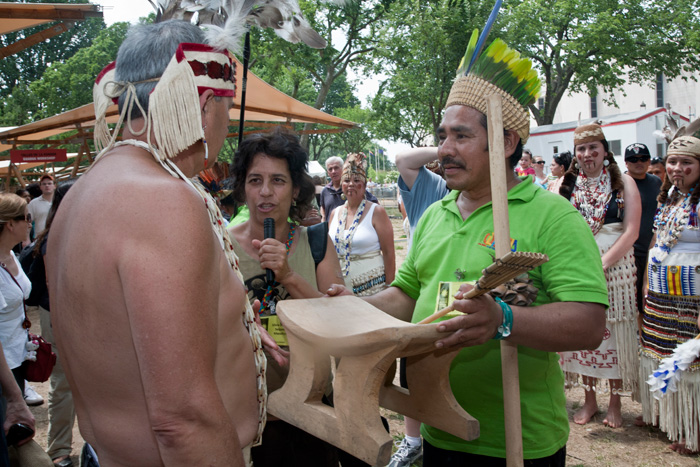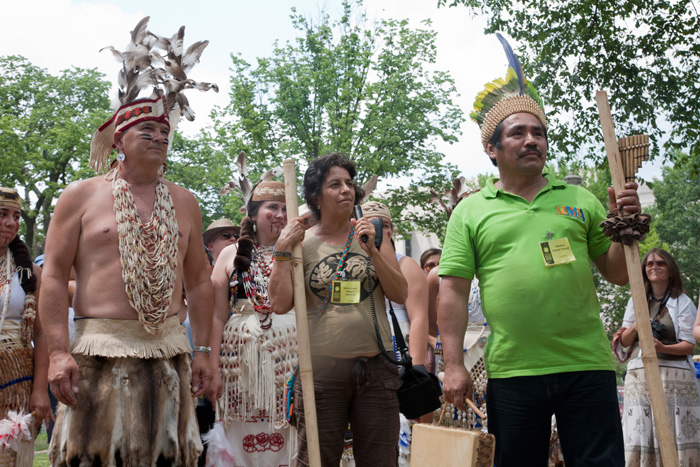Greeting Each Other: American and Colombian Indigenous Peoples

Participants in the Colombia program included ritual leaders, musicians, weavers, potters, carvers, and other skilled tradition bearers from the Amazonian region on the eastern side of Colombia. While visitors during the first eight days of the Festival conversed with the diverse participants and admired the many traditions being shared, visitors on July 10 were privileged to witness an unplanned and extraordinary event that, for many, will not be forgotten.
Just before 2:00 p.m., ten dancers from the Confederated Tribes of Siletz Indians of Oregon entered the festival grounds, where ten dancers from indigenous Amazonian communities in Colombia, including the Yucuna, Matapí, Uitoto, Andoque, and Nonuya, awaited them. The two groups lined up facing one another, and took turns formally dancing their welcome and their joy at the encounter.
The Amazonian dancers joined together in close formation and moved as a group while dancing. Then the men played a flute song. At last, Uldarico Matapí Yucuna, a Matapí elder and shaman who hails from a long line of shamans, took the microphone and gave a formal welcome on behalf of the Colombians, speaking in Spanish: "From this day forward, let our peoples be together, and let us never be separated again." To this, Siletz elder and ritual leader Bud Lane responded with deep appreciation for both the dance and the words, concluding, "Welcome to my country."
The Siletz dancers performed both men's and women's dances, with the bells and hollow beads of their regalia creating music as they moved. At the conclusion of the dance, the Siletz elder wordlessly offered his own dance drum to the Amazonian elder, who a few moments later, returned the gesture, giving Bud Lane a fine shaman's stool. The Colombian elder said the drum would be kept in the National Museum of Colombia and displayed as a gift to all the people of that nation. Bud Lane said that the stool would likewise be kept in the Siletz museum, along with other sacred objects.
Silvia Salgado, who had been facilitating throughout this encounter, conveyed the message that the indigenous people from the other side of the mountains (the Pacific Coast of Colombia), also wished to greet their relatives from the United States, which they then did.
As it happened, the indigenous people who so movingly expressed this bond between north and south had met only a few hours before. Earlier in the day, Smithsonian research collaborator Emi Ireland and former Folklife Festival program curator Phil Tajitsu Nash had arranged with Festival staff and José Montaño of the Smithsonian National Museum of the American Indian (NMAI) to give the indigenous Amazonian people from Colombia a brief tour of NMAI.
As the Colombian visitors entered NMAI's Great Hall, they encountered representatives of the Confederated Tribes of Siletz Indians from the Pacific Coast side of Oregon, who were hosting a display of their dance regalia. They met Bud Lane, Tribal Vice-Chairman of the Siletz, who is also a celebrated basket weaver and tradition bearer of Siletz culture. In 2006, he had worked with the Folklife Festival's "Carriers of Culture" program to celebrate Native basketry traditions.
The Colombian visitors expressed their admiration at the beautiful workmanship and materials of the dance regalia, and asked Mr. Lane how the regalia was used. Immediately overcoming the language barrier, Mr. Lane held a dance quiver and began to intone a song by way of explanation. The Colombian visitors responded by carefully holding the same object, and softly singing a short segment of one of their songs.
In a spontaneous gesture, Mr. Lane gave each of the ten Colombian visitors a beautiful hand-made Siletz bag. One of the Colombian elders, an expert basketmaker, admired a particular type of ornamental bead made from a seed that the Siletz people use in their regalia. Cheryl Lane gave the elder about a hundred of these beautiful beads, each one of them baked, sized, and drilled by hand.
At this moment, Mr. José Montaño, an NMAI cultural interpreter and educator, appeared and warmly greeted the guests in Spanish, a language that all the Colombian indigenous visitors could understand. Mr. Montaño is himself an indigenous South American from the Aymara community, and his commentary on the NMAI exhibitions was, according to the Colombian guests, a highlight of their visit to the United States. Later that day, Mr. Uldarico Matapí Yucuna from the Colombian group reflected on his visit to the NMAI: "That place opened my eyes. I saw things and understood things there that I have not seen before. I learned more there in 45 minutes than at any other time during my visit here. You see this hotel lobby where we are now sitting? It has no spirit ["alma"]. But that museum, it has spirit."
When it was time for the Colombian visitors to leave the NMAI so that they could be in time for the 11 a.m. opening of the Festival, they expressed their thanks and their regret that they could not stay to watch the Siletz dance program that afternoon. After a few minutes of discussions, Emi Ireland arranged with Mr. Lane and Dr. Olivia Cadaval, curator of the Colombia program at the Festival, to have the Siletz dancers perform on the Festival grounds.
As the Siletz dancers left the Festival grounds for another commitment, the Colombians expressed their wish to meet again with their North American Native relatives, whether in Colombia or the United States. They also stated a strong desire to further explore the collections of the NMAI.
After hearing about how well the Siletz have preserved their culture and language, Mr. Uldarico Matapí Yucuna, an elder and ritual authority, expressed his desire to have a filmmaker assist his people with a cultural preservation project that he envisions: documenting the shamanic language of his people, a special, arcane language that only shamans know. Perhaps that will be a future expression of the bonds that were reaffirmed on this memorable day on the Festival grounds.
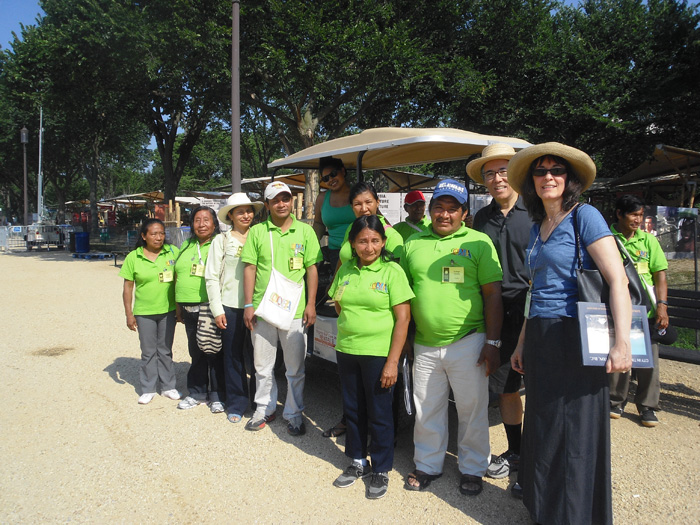
-
The Colombia participants prepare to visit the National Museum of the American Indian.Photo by Sojin Kim
-
Photo by Amulya Mandava/Smithsonian Institution
-
Photo by Van Luong
-
Photo by Amulya Mandava/Smithsonian Institution
-
Photo by Van Luong
-
Photo by Amulya Mandava/Smithsonian Institution
-
Photo by Amulya Mandava/Smithsonian Institution
Emilienne Ireland is a Research Collaborator at the Smithsonian's National Museum of Natural History. For over thirty years, she has studied the language and history of the Wauja, an Amazonian people in Central Brasil.


